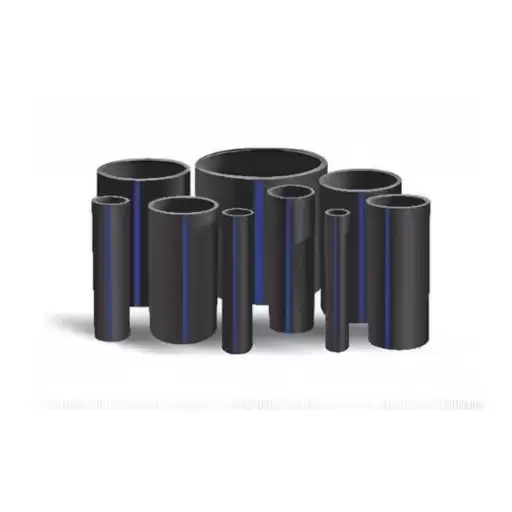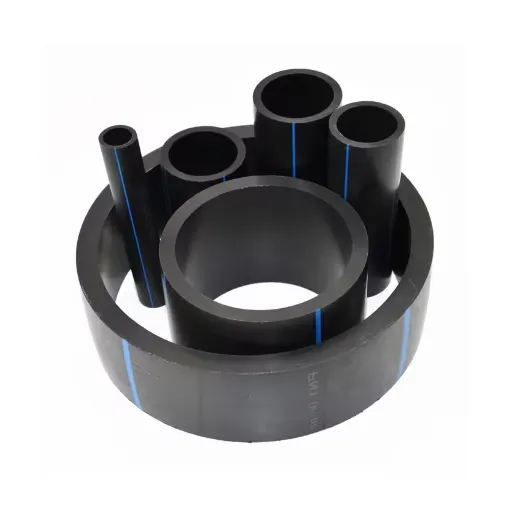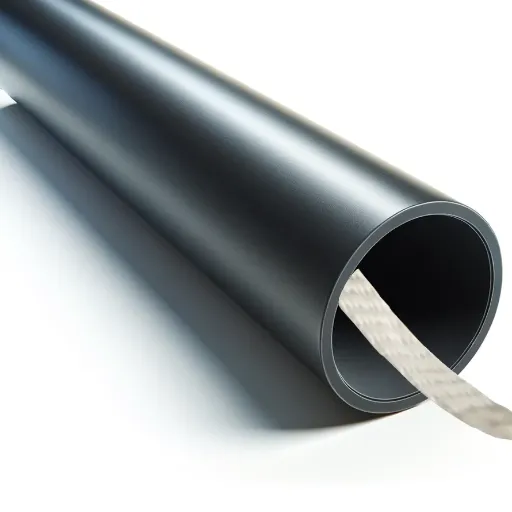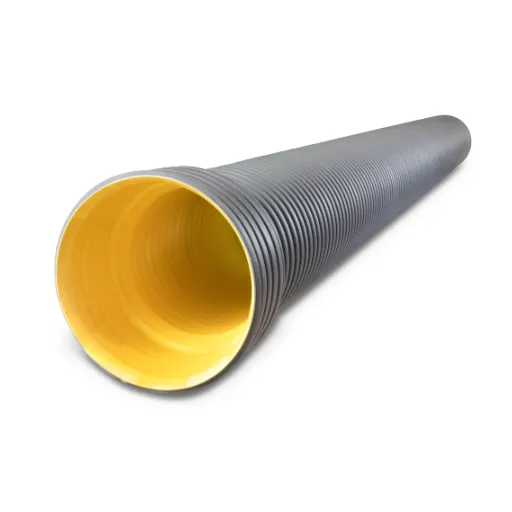High-Density Polyethylene (HDPE) pipes have revolutionized modern construction and infrastructure projects due to their durability, flexibility, and cost-effectiveness. Understanding the appropriate HDPE pipe size for your project is critical to ensuring efficiency and long-term performance. This guide aims to demystify the HDPE pipe size chart, offering a detailed explanation of dimensions, pressure ratings, and applications to help you make informed decisions. Whether you’re planning a water supply system, irrigation project, or industrial application, this blog will serve as a reliable resource to optimize your material selection processes. Stay tuned as we walk you through everything you need to know about HDPE pipe sizing for various applications.
What Are the Standard Sizes for HDPE Pipes?
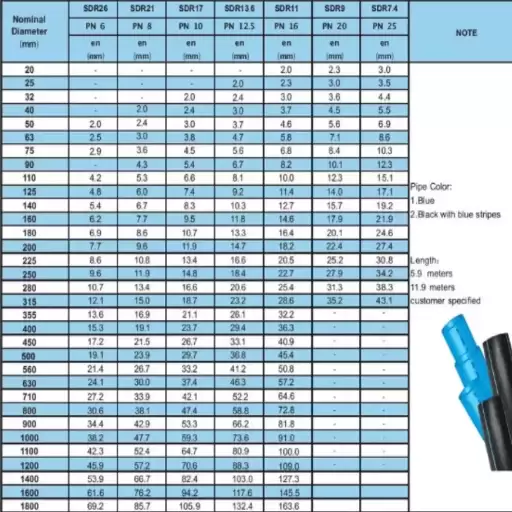
Understanding HDPE Size Specifications
HDPE pipes are made in different sizes to serve the varied needs in water supply, gas distribution, and industrial activities. These sizes are usually described in three measurements: outer diameter(OD), wall thickness, and pressure rating. The outer diameter is a very important factor because it determines the availability of fittings and the flow the pipe is expected to handle. HDPE pipes are grouped by their Standard Dimension Ratio (SDR). This is described as the ratio of the pipe’s outer diameter to its wall thickness. This means an SDR 11 pipe is expected to have a thicker wall than an SDR 17 of the same diameter, hence able to withstand higher pressure.
The pressure ratings for HDPE pipes are also indicative of their SDR and expressed in pounds per square inch (psi). Common pressure ratings include 100, 160, 200 psi etc. with higher ones having Higher tolerance to pressure. It is Exceedingly important to know that pressure ratings are changed by the operating temperature; higher temperature means lower pressure capacity of the pipe.
Like other pipes, HDPE pipes have standardized dimensions that are guided by groups. Nominal sizes are traditionally between ½ inch to 63 inches in diameter. However, larger diameters are intended for use in municipal water systems or industrial-grade wastewater facilities. These standards allow the different manufacturers to maintain compatibility with one another and use the pipes effectively throughout their service life.
Measuring and Wall Thickness in HDPE Pipes
To ensure that an HDPE pipe performs correctly under certain pressures, accurate measurement of HDPE pipe dimensions and wall thickness is critical. The wall thickness is controlled by the pipe’s Standard Deviation Ratio (SDR), which is defined as the ratio between the pipe’s outer diameter and the wall thickness. This SDR value determines the pipe’s pressure rating; for example lower SDR value indicates a thicker wall and high pressure tolerance, whereas a higher SDR value indicates thinner walls, which means a lower pressure capacity.
Ultrasonic testing methods are typically used to measure wall thickness. This technique of non-destructive testing allows a precise assessment without compromising the integrity of the pipe. Some common classifications of HDPE could include, but are not limited to, SDR 11 and SDR 17. These specific values also correspond to certain pressure ratings. For example, PN 16 is for SDR 11, whereas PN 10 is for SDR 17. Furthermore, advanced digital tools now aid in allowing real-time quality checks during the process of manufacturing, which guarantees that the pipes comply with the imposed standards.
This process of taking measurements in their meticulous form is critical in regions such as the natural transportation of gas, water distribution systems, and manage to control industrial fluids. In such cases, even a slight miscalculation in the wall thickness measurement results in dire consequences on safety, operational efficiency, and regulatory adherence.
How to Reference the HDPE Chart for Your Project?
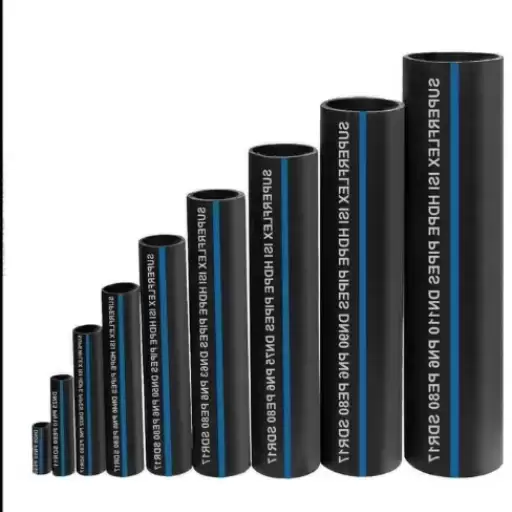
Using the HDPE Chart for Accurate Selection
The HDPE chart is essential for the selection of high-density polyethylene pipes because it helps engineers and technicians detail the requirements of particular applications regarding the size, pressure rating, and other important features. Taking into consideration that proper utilization of the chart requires knowing the following factors:
- Pipe Diameter and Wall Thickness: Ensure that the pipe diameter and application match by selecting the appropriate wall thickness based on the pressure requirement.
- Pressure Ratings and SDR (Standard Dimension Ratio): Check and verify the values of the pressure ratings on the chart. The SDR value will always affect the pressure resistance of the pipe; lower SDR stands for thicker walls and greater pressure resistance.
- Temperature Ratings: The value corresponding to the temperature may also change due to performing different activities at different temperatures. This, therefore, should be factored into the other parameters.
- Specific Applications: Think about the operational surroundings, for example, chemical contact, installation environment, or load conditions. This makes certain that the chosen pipe fulfills both functional and safety requirements.
- Standards of Compliance: Check that all the piping selected has relevant industry and regulatory standards like ASTM, ISO, or others pertinent to your location and project details.
These considerations, when measured against the HDPE chart, give professionals a balanced perspective aligned with engineering needs and safe operation. The efficiency-oriented strategy outlined above greatly reduces risks and guarantees the reliability of the HDPE piping system over time.
Key Factors in Selecting the Right HDPE for Various Applications
It is critical to follow a particular sequence of steps in order to meet the functional and operational HDPE requirements. From environmental conditions to overal mechanical performance, and chemical and thermal properties, each one plays a fundamental role.
- Surrounding Environment: Exposure to corroding or abrasive materials as well as UV radiation, humidity levels and extreme heat are some of the things that stanards the HDPE will get rigorously assed with. HDPE grades, which are suitable for prolonged outdoor applications, have UV stabilization, while industrial environments have highly chemical-resistant variances.
- Load Ratings: It is also important to consider various tests such as tensile strength, impact resistance, and primary pressure ratings, in the fluid mechanics field, for example. Pipes have some concrete siding blasting their stringent over under rated pressures that muddy their fluid intake outflows. That’s dramatically increasing pressure, deversive valves are dialing back, piping flexibility correlates, thus affecting the plastics cruise control.
- Flexibility Standards: Marine and military equipment utilize numerous engines for storing hazardous chemicals, needing permisife poles for x ray buoys along storage and custom pipes. Chemical resistant HDPE become indispensable in some of listed above reasons.
- Thermal Characterization: It is also important to consider the performance of HDPE concerning the entire range of temperatures it may be exposed to. There are applications that will need the materials to work optimally under freezing and high-heat conditions, these scenarios will require selection of grades with superior thermal resistence.
- Durability and Compliance with Standards: For utility or infrastructure applications, the expected useful life of the system is critical and needs to be checked against relevant works at the national or international level, such as ISO 4427 for water pipelines or ASTM D3350 for the classification of the material.
Using industry-grade tools and technical datasheets, professionals, alongside detailed testing data, can simplify the selection process. Tailoring the specific requirement of an application to the material limits the chances of failures, enhances operational life, boosts performance, and ensures effective performance across different fields.
Understanding the Importance of Inner and Outer
Multiple industries rely heavily on the structural integrity and operational efficiency of any material. The inner and outer layers of a material are often one of the primary factors that make this possible. The Support Layer or Inner Layer with enhanced Functionality generally focuses on attributes like Chemical Resistance, Thermal Insulation, and Material Compatibility. An example could be the inner lining of a pipeline system. It must be able to endure high-pressure fluids. Additionally, it must be resilient against corrosive substances and temperature changes. Additionally, comprehensive testing needs to be done, which includes hydrostatic pressure and permeability evaluations.
Moreover, an outer layer is developed to specifically counter external factors. Such factors include UV radiation, mechanical impacts, and even weathering. To further deal with those challenges, advanced coatings and materials are utilized. These are often formulated with performance enhancing additives like UV resistant polymers or abrasion resistant coatings which promise extended performance under the sun.
In conjunction with more modern tools, experimental data provides a deeper insight into behavior modeling. Furtherish combined with risks ensure that international regulations are met which showcases the necessity of evaluating the inner and outer layers of the material extending beyond traditional engineering principles like stress testing. This approach enables engineers to develop designs that adapt to environment prolonging their usability.
What Are the Technical Specifications of HDPE Dimensions?
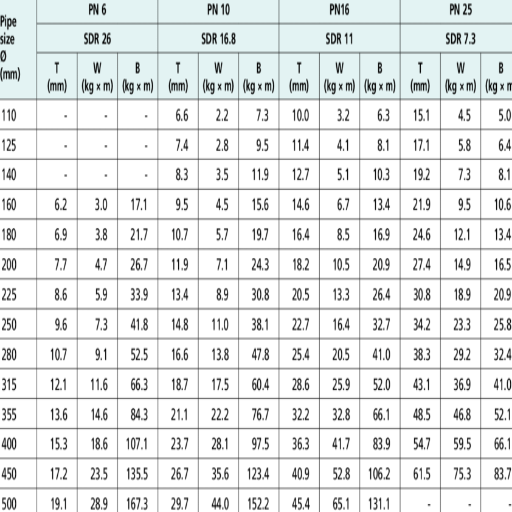
Exploring the Dimensional for HDPE Pipes
High-Density Polyethylene (HDPE) pipes are produced to precise length requirements, assuring dependable functionality across numerous applications. Such requirements are usually controlled by HDPE standards like ASTM, ISO, and DIN, which set the other diameter (OD), wall thickness and pressure ratings. The most commonly utilized standard dimension ratio (SDR) system categorizes pipes based on their OD over wall thickness, allowing engineers to pick products specific to set pressure and durability needs.
For instance, an SDR 11 pipe indicates an OD to wall thickness ratio of 11 which is higher than SDR 17 pipe which is lighter load supporting. HDPE pipes are readily available in store with diameters from 20mm (0.79 inches) to 2000mm (78.7 inches) which offers versatile design features. Moreover, wall thickness differs based on pressure classes usually ranging from PN6 (87 psi) to PN25 (363 psi).
Further advanced manufacturing techniques enable the homogeneous multiple wall thickness presets along HDPE pipe length to provide non-changeable tolerances which aid in the performance of pipe joint connections. Acquiring knowledge of these factors makes it simple for engineers to prepare and optimize system structures while ensuring devices meet industry demands.
How Wall Thickness and Rating Affect HDPE Performance
The efficiency of High-Density Polyethylene (HDPE) Piping systems is greatly impacted by their wall thickness, which determines the pressure rating, or SDR. Wall thickness, also known as Standard Dimension Ratio (SDR), directly corresponds to the amount of pressure and mechanical stress a pipe can endure. Internal pressure would deform, damage, or fracture a pipe with an SDR value lower than its rated capacity. For instance, most HDPE pipes are 11 SDR, which allows them to tolerate up to 160 psi, while 17 SDR pipes can only endure up to 100 psi under the same operating conditions.
Other than wall thickness, pressure rating is affected by the material’s properties such as long-term hydrostatic strength, stress regression, and compliance with standards ASTM D2837 and ISO 12162, which standard aids in measuring performance over 50 years using norm temperatures. These standards dictate how the pipe is tested, and combined with a 50-year norm working temperature, create consistent results. In addition, performance is highly sensitive to temperature variations, and increased external temperature greatly reduces the pressure rating. HDPE pipe rated at 160 psi at 73°F (23°C), as that rating will diminish with surging temperature dictated by manufacturer derating factors.
An engineer needs to examine every relevant application detail, including the degree of chemical endurance, environmental factors, and pumping requirements, to fine-tune the performance. Precision in system design can make the difference between optimal application and inefficiency, or even lead to structural weaknesses in higher SDR-rated pipes and low-demand situations, and the opposite case.
Why is the HDPE Size Chart Crucial for Infrastructure Projects?
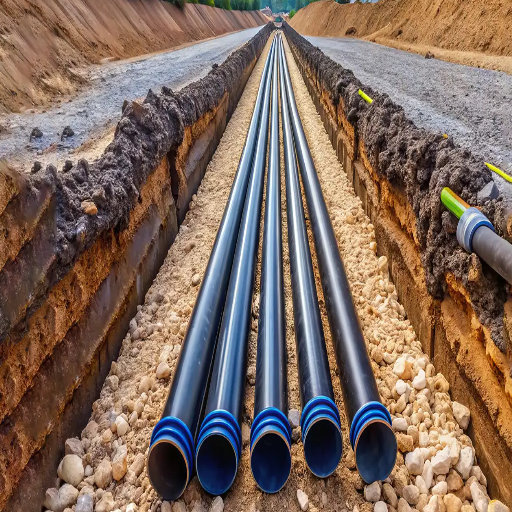
Understanding the Role of HDPE Pipes in Potable Water Systems
The superior characteristics of HDPE (high-density polyethylene) pipes make them a critical component of modern potable water systems. An extremely important benefit of HDPE pipes is their corrosion resistance, because of which, performance and durability are not compromised even in aggressive soil and water conditions, unlike traditional materials such as galvanized steel and concrete. HDPE pipes, unlike other materials, do not scale, rust, or build biological matter, thus maintaining the quality of water throughout the long lifespan of the pipes.
HDPE pipes have an impressive amount of flexibility and strength which enables them to endure ground movement and seismic stresses without losing structural integrity. This is beneficial in areas that are prone to earthquakes or have unstable soil condition regions. Such capability to absorb stress reduces the chances of cracks, leaks, joint separations, and increased maintenance costs along with minimal system downtime.
Economically and environmentally, HDPE pipes are energy efficient due to their smooth internal surfaces, which lessen friction loss. Improved flow capacity is offered as well. Reduced friction significantly lessens energy use in the pumping system, benefiting overall operational efficiency. In addition, heat fusion at the joints of HDPE pipes forms a piping system that is continuous and free of leaks and adds gaps that do not require extra mechanical joints or seals, which is typical in other systems, eliminating failure points.
In conclusion, the easy transport and installation due to light lightweight of HDPE pipes reduces labor costs and project duration. Cost-effective, HDPE pipes are adaptable to different pressure classifications and diameters, ensuring system designers have the flexibility to address specific project needs for potable water infrastructure. With these characteristics, HDPE pipes maintain the standard for reliability and efficiency in today’s water systems.
Utilizing HDPE Pipes for Gas Distribution and Other Industries
Gas distribution is one of the use cases of high-density polyethylene (HDPE) pipes because of their high durability, flexibility, as well as resistance to shelf elements. Their inertness makes sure there are no leaks or degradation due to corrosion while transporting natural gas. Moreover, the exceptional resistance of HDPE pipes to crack propagation is essential in high-pressure gas systems, in addition to being beneficial in long-term applications in different environments.
In addition to the above, mining, chemical processing, and sewage systems also utilize HDPE pipes for industrial purposes. Their lightweight and highly flexible design allows for effective installation in challenging terrains to be done cost-effectively. Transport of fluids through pipes is a common functionality in industries, thus, HDPE pipes are preferred due to their ability to withstand extreme temperatures and pressures while maintaining structural integrity. Leakage prevention is very important in many industries where operational reliability is critical; this requirement is ensured by the ease of fusion welding of the material.
Agricultural irrigation and geothermal energy are some of the new added sectors which deal with the versatile nature of HDPE pipes, thus aiding in the assistance of innovative sustainable practices. A combination of industry performance advantages and meeting specific regulatory standards makes HDPE pipes leaders in infrastructure and industrial development while providing unmatched value to a wide array of businesses.
Meeting Industry with Comprehensive Pipe Sizing
All aspects of pipe hydraulic design rely on effective pipe sizing, and also identify the strategy to maximize streamlined flow within any industrial system. The algorithm must consider a great set of factors which include the flow volume and type, pressure class, temperature range, and whether the chemical will not corrode or react with the material. Energy loss and pressure drop are avoided with a properly sized system, which gives the added benefit of extending operational longevity.
Currently, advanced numerical methods and simulations are altering the way pipe measurements are taken by providing automation in dimensional pipe design. These algorithms account for the system requirements like fluid dynamics, material of the pipe, and recommend them with information suitable for actual applications. An example is the widely adopted Darcy-Weisbach equation for hydraulic design that uses flow velocity and diameter of the pipe to optimize several outputs and sidestep frictional head loss.
Such piping establishes operational cost reductions, risk mitigation, and sustainable growth from their traditional engineering effort combined with cutting-edge preemptive modeling.
How to Factor in HDPE for Optimal Design?
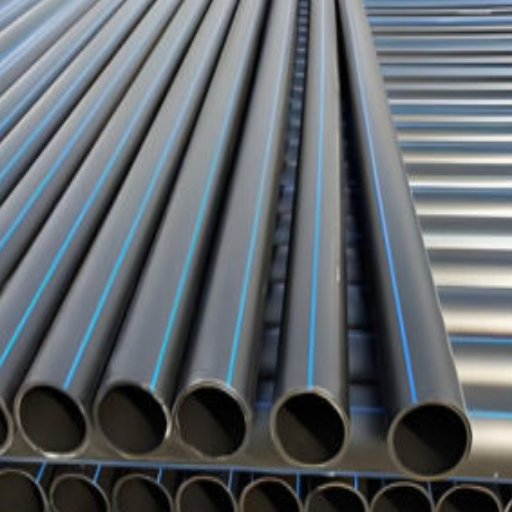
Calculating the Minimum Wall Thickness
To achieve uniformity and compliance with engineering practices, calculations concerning the minimum wall thickness for black steel pipes require particular attention. For the ease of understanding, some important criteria are compiled in a tabular form:
|
Key Point |
Description/Formula |
|---|---|
|
Pipe Material |
Black steel with defined tensile strength. |
|
Design Pressure (P) |
Pressure inside the pipe (e.g., psi or MPa). |
|
Outer Diameter (OD) |
Measured diameter of the pipe (inches or mm). |
|
Allowable Stress (S) |
Stress the material can handle (e.g., psi). |
|
Corrosion Allowance (CA) |
Added thickness to account for corrosion (e.g., mm or inch). |
|
Joint Efficiency (E) |
Efficiency of welds or connections (0 < E ≤ 1). |
|
Wall Thickness Formula |
\( t = \frac{P \times OD}{2 \times S \times E} + CA \) |
|
Safety Factor |
Consider additional safety margins for high-pressure systems. |
|
Check for Standards |
Ensure compliance with local piping regulations and codes. |
With the formula \( t = \frac{P \times OD}{2 \times S \times E} + CA \), engineers calculate the minimum wall thickness a component can optimally sustain while maintaining reliability and design code compliance.
Integrating HDPE Sizing in Various Infrastructure Projects
When incorporating pipe sizing of high-density polyethylene (HDPE) into the infrastructure designs of a project, it is essential to consider all project-specific needs and the material’s HDPE properties. These pipes are particularly suited for water distribution systems, gas pipelines, and sewer pipelines because they are highly corrosion resistant, ductile, and have a long service life. Proper pipe sizing begins with an assessment of the expected flow rates, pressure ratings, and environmental stressors for the given project.
For example, in water transmission, systems require HDPE engineers to look into parameters of pipeline surges such as peak demand flow rate, turbulence limits imposed by velocity, and the maximum pressure the pipe can withstand while maintaining durability. Regarding gas pipelines, the design temperature fluctuation resistance and permeation resistance have to be considered as well.
HDPE size standards undergo thorough consideration. Complete planning at the beginning as well as analysis of the lifecycle cost assists in evaluation of the long term maintenance and replacement scenarios of the HDPE and determines economically optimal position in the scenario.
Ensuring Compatibility with and IPS Standards
At first, making sure that the selected HDPE materials are within the standards for specific applications is my main focus when dealing with compatibility with the Industry Practice Specifications (IPS) standards. After going through the IPS instructions, I verified that the material’s specifications, pressure ratings, and dimensional tolerances are within operational limits such as resistance to chemicals and the material’s ability to endure solar radiation, temperature, and other environmental and operational strains. For my analytical assessment of chemical resistance, I make sure that the components can resist UV exposure and strain from operational and environmental stressors.
Furthermore, the use of IPS-defined connectors and comprehensive examination of their arrangement concerning joints and ties adds to the determination of compatibility. I try to adhere to the use of accepted techniques such as heat fusion or mechanical fittings per the standard, since failure to do so may damage system functionality, introduce changes to critical failure locations. Moreover, I perform operational testing and validate that the installed systems fall within the safe limitations of operation, effectiveness, and efficiency. For conformance with performance criteria, this includes hydrostatic pressure testing and frequent quality control during installation.
As I mentioned above, continuous documentation and validation processes ensure that the workflow implementation meets IPS compliance requirements. This encompasses all record inspections, order compliance installations, and compliance standards training. Adequate planning, execution, and evaluation after system installation ensure that IPS standards are upheld alongside HDPE system functionality, reliability, efficiency, and usability.
References
Frequently Asked Questions (FAQ)
Q: What is an HDPE pipe size chart, and why is it important?
A: An HDPE pipe size chart provides detailed information on the dimensions of HDPE pipes, including the outside diameter and inner diameter. It is crucial for selecting the right pipe for various projects and ensuring compatibility with existing systems.
Q: How do HDPE pipe dimensions affect their application in various industries?
A: HDPE pipe dimensions, such as the inside diameter and outside diameter, determine the flow capacity and pressure rating, which are essential for applications in various industries, including water applications and other specific uses.
Q: What are the standard HDPE pipe sizes available?
A: Standard HDPE pipe sizes are often based on the ductile iron pipe size system and can vary by metric or imperial measurements. These sizes ensure that the pipe meets the necessary specifications for different applications.
Q: How does the inner diameter of an HDPE pipe influence its performance?
A: The inner diameter of an HDPE pipe affects the flow rate and pressure capabilities. A larger inner diameter allows for greater flow, which is critical for water applications and other projects depending on the application.
Q: What role does the outside diameter play in the selection of HDPE pipes?
A: The outside diameter is a critical factor in ensuring that HDPE pipes fit correctly with existing infrastructure and meet the requirements of specific projects. It helps in determining the pipe’s compatibility with other systems.
Q: How can one determine the appropriate HDPE pipe size for a specific project?
A: Determining the appropriate HDPE pipe size involves considering factors such as the average flow rate, pressure requirements, and specific project needs. Consulting a size chart and understanding the id and outside diameter are crucial steps in this process.
Q: What are some common applications of HDPE pipes, and how do dimensions play a role?
A: HDPE pipes are used in water applications, gas distribution, and more. The dimensions, including the inside and outside diameter, play a vital role in ensuring that the pipe meets the specific demands of these applications, depending on the application requirements.



